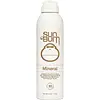What's inside
What's inside
 Key Ingredients
Key Ingredients

 Benefits
Benefits

 Concerns
Concerns

 Ingredients Side-by-side
Ingredients Side-by-side

Zinc Oxide 14%
Cosmetic ColorantWater
Skin ConditioningHelianthus Annuus Flower
Skin ConditioningButyloctyl Salicylate
Skin ConditioningCarthamus Tinctorius Seed Oil
MaskingCaprylic/Capric Triglyceride
MaskingBentonite
AbsorbentMethyl Dihydroabietate
Parfum
MaskingCetearyl Alcohol
EmollientAloe Barbadensis Leaf Juice
Skin ConditioningGlycerin
HumectantMicrocrystalline Cellulose
AbsorbentCellulose Gum
Emulsion StabilisingCoco-Glucoside
CleansingCaprylhydroxamic Acid
Caprylyl Glycol
EmollientJojoba Esters
EmollientBisabolol
MaskingTocopherol
AntioxidantPolyhydroxystearic Acid
EmulsifyingZinc Oxide 14%, Water, Helianthus Annuus Flower, Butyloctyl Salicylate, Carthamus Tinctorius Seed Oil, Caprylic/Capric Triglyceride, Bentonite, Methyl Dihydroabietate, Parfum, Cetearyl Alcohol, Aloe Barbadensis Leaf Juice, Glycerin, Microcrystalline Cellulose, Cellulose Gum, Coco-Glucoside, Caprylhydroxamic Acid, Caprylyl Glycol, Jojoba Esters, Bisabolol, Tocopherol, Polyhydroxystearic Acid
Butyl Methoxydibenzoylmethane 3%
UV AbsorberHomosalate 10%
Skin ConditioningEthylhexyl Salicylate 5%
UV AbsorberOctocrylene 10%
UV AbsorberWater
Skin ConditioningStyrene/Acrylates Copolymer
Silica
AbrasiveDimethicone
EmollientPotassium Cetyl Phosphate
EmulsifyingBenzyl Alcohol
PerfumingBeeswax
Emulsion StabilisingCaprylyl Methicone
Skin ConditioningGlyceryl Stearate
EmollientPEG-100 Stearate
Cetyl Dimethicone
EmollientCaprylyl Glycol
EmollientEthylhexylglycerin
Skin ConditioningAluminum Starch Octenylsuccinate
AbsorbentBehenyl Alcohol
EmollientAcrylates/Dimethicone Copolymer
Skin ConditioningXanthan Gum
EmulsifyingSodium Polyacrylate
AbsorbentChlorphenesin
AntimicrobialDimethicone/PEG-10/15 Crosspolymer
Hydrolyzed Jojoba Esters
Skin ConditioningParfum
MaskingDisodium EDTA
Ethylhexyl Stearate
EmollientTocopheryl Acetate
AntioxidantBHT
AntioxidantTrideceth-6
EmulsifyingJojoba Esters
EmollientButyl Methoxydibenzoylmethane 3%, Homosalate 10%, Ethylhexyl Salicylate 5%, Octocrylene 10%, Water, Styrene/Acrylates Copolymer, Silica, Dimethicone, Potassium Cetyl Phosphate, Benzyl Alcohol, Beeswax, Caprylyl Methicone, Glyceryl Stearate, PEG-100 Stearate, Cetyl Dimethicone, Caprylyl Glycol, Ethylhexylglycerin, Aluminum Starch Octenylsuccinate, Behenyl Alcohol, Acrylates/Dimethicone Copolymer, Xanthan Gum, Sodium Polyacrylate, Chlorphenesin, Dimethicone/PEG-10/15 Crosspolymer, Hydrolyzed Jojoba Esters, Parfum, Disodium EDTA, Ethylhexyl Stearate, Tocopheryl Acetate, BHT, Trideceth-6, Jojoba Esters
 Reviews
Reviews

Ingredients Explained
These ingredients are found in both products.
Ingredients higher up in an ingredient list are typically present in a larger amount.
Caprylyl Glycol is a humectant and emollient, meaning it attracts and preserves moisture.
It is a common ingredient in many products, especially those designed to hydrate skin. The primary benefits are retaining moisture, skin softening, and promoting a healthy skin barrier.
Though Caprylyl Glycol is an alcohol derived from fatty acids, it is not the kind that can dry out skin.
This ingredient is also used as a preservative to extend the life of products. It has slight antimicrobial properties.
Learn more about Caprylyl GlycolJojoba Esters is a wax created from Jojoba oil. It is an emollient and film-forming ingredient. In bead form, it is an exfoliator.
This ingredient has high oxidative stability, meaning it doesn't break down when exposed to oxygen.
Its similarity to our skin's natural oils makes it a great emollient. Emollients help soften and soothe our skin by creating a barrier on top. This barrier helps trap moisture in, keeping skin hydrated.
It is created using either the hydrogenation or transesterification processes on jojoba oil.
Learn more about Jojoba EstersParfum is a catch-all term for an ingredient or more that is used to give a scent to products.
Also called "fragrance", this ingredient can be a blend of hundreds of chemicals or plant oils. This means every product with "fragrance" or "parfum" in the ingredients list is a different mixture.
For instance, Habanolide is a proprietary trade name for a specific aroma chemical. When used as a fragrance ingredient in cosmetics, most aroma chemicals fall under the broad labeling category of “FRAGRANCE” or “PARFUM” according to EU and US regulations.
The term 'parfum' or 'fragrance' is not regulated in many countries. In many cases, it is up to the brand to define this term.
For instance, many brands choose to label themselves as "fragrance-free" because they are not using synthetic fragrances. However, their products may still contain ingredients such as essential oils that are considered a fragrance by INCI standards.
One example is Calendula flower extract. Calendula is an essential oil that still imparts a scent or 'fragrance'.
Depending on the blend, the ingredients in the mixture can cause allergies and sensitivities on the skin. Some ingredients that are known EU allergens include linalool and citronellol.
Parfum can also be used to mask or cover an unpleasant scent.
The bottom line is: not all fragrances/parfum/ingredients are created equally. If you are worried about fragrances, we recommend taking a closer look at an ingredient. And of course, we always recommend speaking with a professional.
Learn more about ParfumWater. It's the most common cosmetic ingredient of all. You'll usually see it at the top of ingredient lists, meaning that it makes up the largest part of the product.
So why is it so popular? Water most often acts as a solvent - this means that it helps dissolve other ingredients into the formulation.
You'll also recognize water as that liquid we all need to stay alive. If you see this, drink a glass of water. Stay hydrated!
Learn more about Water